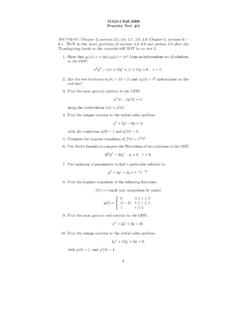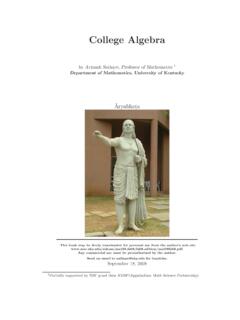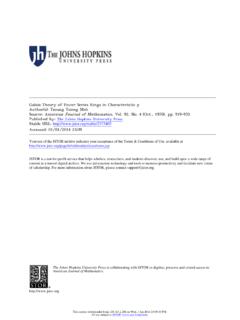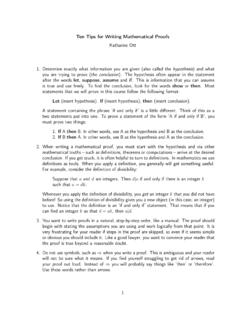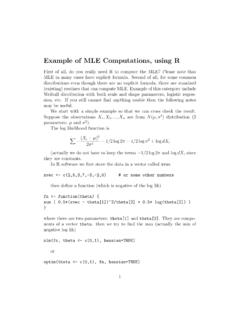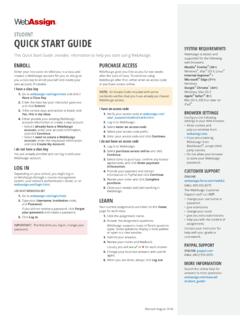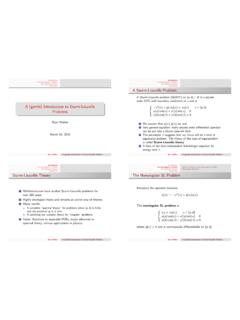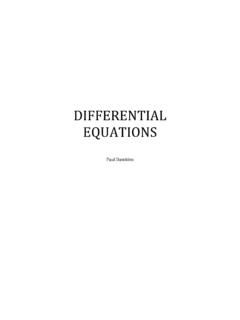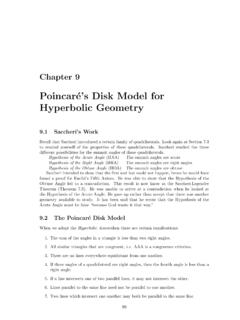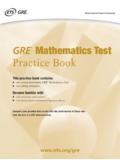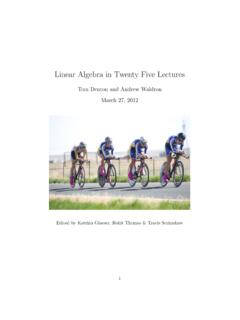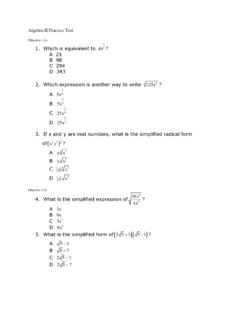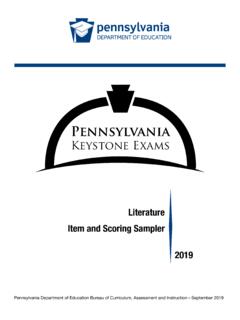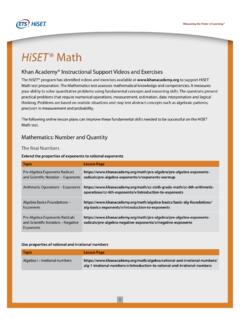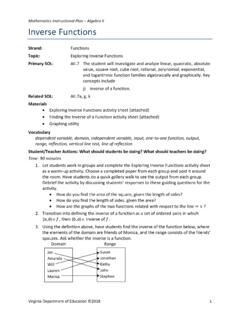Transcription of College Algebra - Mathematics
1 College Algebraby Avinash Sathaye, Professor of Mathematics1 Department of Mathematics , University of Kentucky book may be freely downloaded for personal use from the author s web commercial use must be preauthorized by the an email to for 18, 20081 Partially supported by NSF grant thru AMSP(Appalachian Math Science Partnership) book represents a significant departure from the current crop of commercialcollege Algebra textbooks. In our view, the core material for the (non-remedial)courses defined by these tomes is but a shadow of that traditionally covered materialin a reasonable high school program. Moreover, much of the material is substantiallyrepeated from earlier study and it proceeds at a slow pace with extensive practice anda large number of routine exercises. As taught, such coursestend to be ill-advisedattempts to prepare the student for extensive calculationsusing calculators, withsupposed real life examples offered for motivation and practice.
2 Given the limitedtime and large number of individual topics to study, the average student emerges,perhaps, with the ability to answer isolated questions and the well-founded view thatthe rewards of the study of Algebra (and of Mathematics in general) lie solely in theexperience of applying opaque formulas and mysterious algorithms in the productionof quantitative rational, intelligent individuals with many demands on their time, students insuch an environment are more than justified when they say to the teacher: don ttell me too many ways of doing something; don t tell me how theformula is derived;just show me how to do the problems which will appear on the test!. Individuals, whoexperience only this type of Mathematics leave with a staticcollection of tools andperhaps the ability to apply each to one or two elementary or artificial situations.
3 Inour view, a fundamental objective of the students mathematical development shouldbe an understanding of how mathematical tools are made and the experience ofworking as an apprentice to a teacher, learning to build his or her own basic toolsfrom the ground up. Students imbued with this philosophy are prepared to profit asmuch from their incorrect answers, as from their correct ones. They are able to view asmall number of expected outcomes of exercises as a validation of their understandingof the underlying concepts. They are further prepared to profit from those real worldapplications through an understanding of them as elementary mathematical modelsand an appreciation of the fact that only through a fundamental understanding ofthe underlying Mathematics can one understand the limits ofsuch models. Theyunderstand how to participate in and even assume responsibility for their subsequentmathematical text is intended to be part of a College Algebra course which exposes studentsto this philosophy.
4 Such a course will almost certainly be a compromise, particularlyif it must be taught in a lecture/recitation format to large numbers of emphasis in this course is on mastering the Algebraic technique. Algebrais a discipline which studies the results of manipulating expressions (according to aset of rules which may vary with the context) to put them in convenient form, forenhanced understanding. In this view, Algebra consists of looking for ways of findinginformation about various quantities, even though it is difficult or even impossible toexplicitly solve for them. Algebra consists of finding multiple expressions for the samequantities, since the comparison of different expressions often leads to new is our sincere request and strong advice to the reader: We urge the readers to approach this book with an open mind. Ifyou do, thenyou will find new perspective on known topics.
5 We urge the reader to carefully study andmemorizethe definitions. A majorityof mistakes are caused by forgetting what a certain term means. We urge the reader to be bold. Don t be afraid of a long involved designed to reach an answer in just a step or two, often hide the truemeaning of what is going far as possible, try to do the derivations yourself. If youget stuck, look upor ask. The derivations are not to be memorized, they should be done as a freshexercise in Algebra every time you really need them; regularexercise is goodfor you! We urge the reader to be inquisitive. Don t take anything forgranted, until youunderstand it. Don t ever be satisfied by a single way of doingthings; look foralternative shortcuts. We also urge the reader to be creatively lazy. Look for simpler (yet correct, ofcourse) ways of doing the same calculations.
6 If there is a string of numericalcalculations, don t just do them. Try to build a formula of your own; perhapssomething that you could then feed into a computer some warning about are a big help in understanding the prob-lem and they help you set up the right questions. They are alsonotorious for mis-leading people into wrong configurations or suggesting possible wrong answers. Nevertrust an answer until it is verified by theory or straight are useful for getting answers but in this course most questions aredesigned for precise algebraic answers. You can and should use the calculators freelyto do tedious numerical calculations or to verify your work or intuition. But youshould not feel compelled to convert every answer into a decimal number, howeverprecise. In this course68and1+ (2)1 (7)are perfectly acceptable answers unless theinstructions specify a specific form.
7 A computer system which is capable of infiniteprecision calculations can be used for study and is recommended. But make sure thatyou understand the calculations suggestion about do value the creation and understanding ofa proof, but often it is crucial that you get good at calculations before you knowwhat they mean and why they are valid. Throughout the book youwill find sectionsbilled as optional or can be omitted in a first reading . Westrongly urge that youmaster the calculations first and then return to these for further many places, you will find challenges and comments for attentive or alert read-ers. They can appear obscure if you are new to the material, but will become clearvas you get the feel of it. Some of these are subtle points which may occur to youlong after the course is finished! In other words, don t be discouraged if you don tget these right reader will quickly note that although there are numerous worked examples,there are very few exercises in this text.
8 In particular there are no collections ofproblems from which the instructor might assign routine homework. Those exist,but they are in electronic form and provided through the Web Homework System(WHS) at ( ). The system was created by my University ofKentucky (UK) colleague Dr. Ken Kubota. The problems themselves were preparedby myself and UK colleague Dr. Paul Eakin using the Maple problem solving systemwith the MCtools macro package developed by our UK colleagueDr. Carl initial version of this text was used in pilot sections ofCollege Algebra taughtat UK in spring 2005 by Paul Eakin, our colleague and department chair, Dr. RickCarey, and by then pre-service teachers: Amy Heilman and Sarah that pilot, the text was extensively revised and used for about 1500students in a large-lecture format at UK in fall 2005 and about 450 students in spring2006.
9 The results for fall were:31% As, 20% Bs, 14% Cs,6% Ds, and 9% Fs (UK callsthem Es), and 20% the spring the outcomes were: As, Bs, 15% Cs, Ds, Fs, and Ws. In the spring, six Eastern Kentucky high school studentstook the course by distance learning: four made As and two dropped because ofconflicts with sports summer 2006, I worked with a team of 22 mathematicians: eighteen high schoolteachers, one Mathematics education doctoral student, andthree UK math facultywent through a week-long (30 hour) seminar which went (line by line, page by page)through the entire text and all of the online homework problems, discussing in detailsuch course characteristics as the underlying philosophy,the mathematical content,topic instructional strategies, alignment of homework andtext material, alignmentwith high school curricula, etc. The results of that tremendous amount of effort wereincorporated into the third major iteration of the text and third edition was used in Fall 2006 and Spring 2007 for both College andsecondary students in a program called Access to Algebra which is sponsored by theNational Science Foundation (NSF) and the University of Kentucky (UK).
10 In thatprogram secondary students, mentored by their school math teachers, take the UKCollege Algebra course at no cost. The students take the samecourse in lockstepwith a matched cohort of College students, doing the same homework and taking thesame uniformly graded (and hand graded) examinations on thesame has now completed her masters degree in Mathematics and joined Sarah on the mathematicsfaculty of Paul Laurence Dunbar High School in Lexington, program was coordinated by Lee Alan Roher. She was assisted by JasonPridemore, Beth Kirby, and April Pilcher. The outcomes wereABCD E(F) WFall 2006: 45 College students33% 27% 18% 0% 16% 7%Fall 2006: 41 secondary students58% 7% 10% 7% 16% 17%Spring 2007: 60 College students50% 33% 4% 0% 4% 8%Spring 2007: 24 secondary students 58% 18% 20% 3% 14% 15%Fall 2007: 33 College students39% 29% 12% 10% 2% 7%Fall 2007: 45 secondary students43% 19% 10% 6% 5% 17%Spring 2008: 41 secondary students 34% 17% 16% 9% 5% 18%The outcomes in the general, conventional College program which uses a commer-cial text were:ABCD E(F) WFall 2006: 1449 College students 17% 23% 21% 12% 12% 17%Spring 2007: 663 College students 17% 21% 18% 14% 17% 14%Fall 2007: 1608 College students 21% 26% 23% 11% 9% 10%The member of the summer 2005 development team members were.
